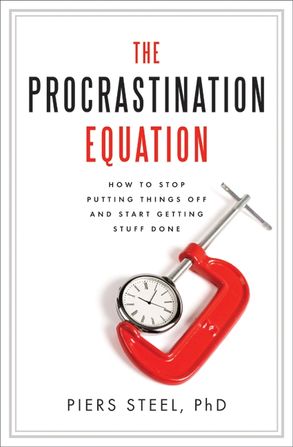The Procrastination Equation Book Review – Are you as efficient as you can be?
Hello again, fellow coders/entrepreneurs! This week, i’ll be reviewing the fantastic book The Procrastination Equation by Piers Steel.
I got to know this book when i was… well… procrastinating on Reddit and found this chart in a post:
I love these kinds of schematics, and this one immediately caught my eye. While definitely not simple, i really felt like something was up with it, and simply knew i had to read the book where it came from to learn more about every single one of these colorful squares. And i was pleasantly surprised to find that not only every single one of them is deeply detailed in the book, but also that it contains tons of research backing up its claims and also that there is a higher level concept embracing all of them.

The Procrastination Equation Book Cover
The book begins by describing what is the profile of a procrastinator. It has a simple set of questions that tells you in which category of procrastinators you are, and quite a few examples of common procrastinator attitudes. After this setup, it showcases the so-called procrastination equation, that says:
MOTIVATION = ( EXPECTANCY * VALUE ) / ( IMPULSIVENESS * DELAY )
where
- Motivation is how determined we are to actually accomplish something.
- Expectancy is what we expect the outcome to be, that is, how likely we think it is that we will succeed.
- Value is the perceived gain that we will have by finishing some task.
- Impulsiveness is our tendency to act towards smaller gains, or how sensitive we are to delays.
- Delay is how long it is going to take for us to accomplish our goals.
The next few chapters detail the origin and consequences of procrastination. I would say that if all you’re looking for is some way to get out of procrastination habits, you can safely skip these chapters. On the other hand, if you, like me, enjoy reading about research, the chapter three to six are fascinating, particularly chapter three, “Wired for procrastination”, that explains how our mammal brains keep us from reaching our goals.
The actual description of the techniques you can use to beat procrastination begin on chapter seven, “Optimizing optimism” (the yellow squares on the chart above). Basically, it says how to fine tune your expectatives so that you don’t believe tasks are impossible but also don’t become overconfident (and thus, delay a task because you think it would be too easy).
An actual segment of the chapter that just fits too well with entrepreneurship is the notion of success spirals. Imagine you’re trying to create a multi-millionaire business (who isn’t?), but you don’t realistically believe you can pull it off. What the book suggests you to do: strive to improve just a little beyond your present skill set so that reaching this goal becomes easier. In our example, have you ever built a e-mail list? A simple, straightforward landing page? No need to build the whole company at once: start at a simple point, that you can realistically achieve, and your eventual success should inspire you to actually reach further (as in a spiral).
The next chapter, “Love it or leave it”, talks about value (the blue squares). I think this quote best summarises what this part is all about:
Suppose you had to decide what to do for just the next five minutes—either work on the paper or play one game of pinball. The paper can wait for one game—there is little long-term cost. In the short run, five minutes of pinball is far more pleasurable than five minutes of paper writing, and after all, how much of a paper can you do in five minutes? Pinball is the obvious choice. The game is over so you must decide about the next five minutes. The situation is only trivially changed, so you will reach the same result. Once you’ve taken the possibility of pinball seriously and fragmented your night into five-minute intervals, you may be doomed to play until you run out of money, the machine breaks, someone meaner than you wants to play. The trouble is, even five minutes has a real cost to the paper. Because a single game of pinball is brief, it is particularly seductive.
In my experience, building a whole software system (and a company) feels just like finishing this paper. Playing some game for a few minutes won’t do much to it, but the problem comes when its impossible to stop.
Moving forward, we have “In Good Time”, chapter nine, that speaks about impulsiveness (the green squares). According to the book, this is the hardest part when dealing with procrastination and possibly the one which impacts us the most, but it has useful tips here, too: mainly, it focuses on how to properly declare your goals and actively pay attention to the consequences of your acts. That is, state your goals in a way that includes a (preferentially) short-timed due date and be aware of any distracting temptations.
To wrap it up, i really liked this book, mainly because it is a book on motivation that is backed up by real research (if you read the digital version, you’ll notice the many references in every chapter). In fact, i have already been using some of its tecniques for some time, and am looking forward to share with you my personal productivity framework. Thanks for reading this review, and i hope you found it useful!
Liked this review? Has anything to ask or to add? Reach me on Twitter: @thenameisflic!
